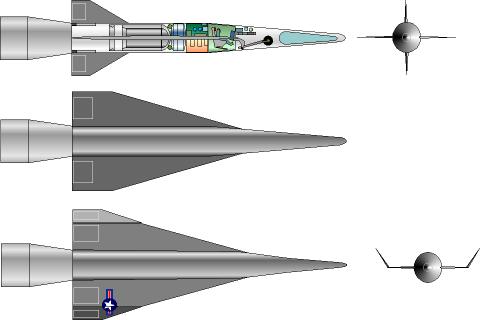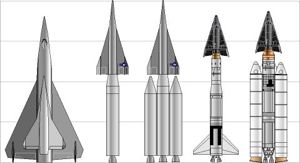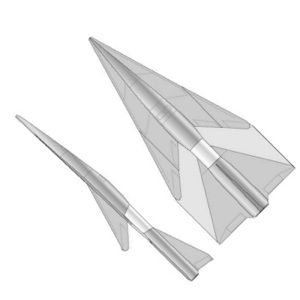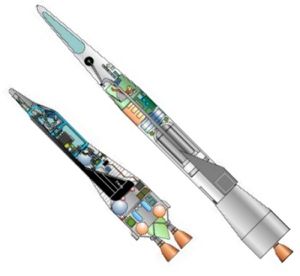
Home - Search - Browse - Alphabetic Index: 0- 1- 2- 3- 4- 5- 6- 7- 8- 9
A- B- C- D- E- F- G- H- I- J- K- L- M- N- O- P- Q- R- S- T- U- V- W- X- Y- Z
Robo

Robo Glider
Two versions of Robo glider, with vertical fins on fuselage and with vertical stabilisers on wing-tips. The latter was the final version.
AKA: Rocket Bomber. Status: Study 1955.
In 1955 the Air Force began extending study of manned hypersonic weapon systems beyond the Bomi work underway at Bell since 1952. Six companies undertook preliminary studies using their own funds in 1955 at the request of the government. On 19 December 1955 the USAF issued a Request or Proposal for preliminary design of a manned hypersonic bomber. Boeing, Convair, Douglas, McDonnell, North American, and Republic responded. SR-126 for a ROcket BOmber was released in June 1956, and Convair, Douglas, and North American received modestly-funded study contracts totaling $860,000. Payload was to be from 740 to 1500 to 11,400 kg, and the bomber was to have a secondary reconnaissance mission. Final reports were presented to the government in June 1957, by which time a total of $ 3.2 million of government and company funds had been spent on manned hypersonic combat aircraft. The level of effort and nature of the contractor approaches were as follows:
- Bell had expended the most effort, producing a total of 50 papers, covering every aspect of the design of a manned hypersonic aircraft. This had been funded by $ 2.156 million in government funds and well over $ 1million of company funds from 1954-1957. Their final design was a large delta-winged glider with a mid-level wing. The internal structure was of conventional aluminum honeycomb, actively cooled by water pumped through channels on the outer surface. On top of this was a quartz fiber insulation layer. The outer skin of the aircraft was made of Inconel-X nickel alloy. The temperature of the outer skin was expected to be 1200 deg C. The leading edges of the wing would reach 2500 deg C and would be actively cooled by a liquid sodium system.
The glider itself had a total mass of 11 metric tons with a 1300 kg nuclear warhead. It would be boosted by three modular fluorine/ammonia boosters with a total lift-off mass of 336 metric tons on the following mission profile:
- First stage (two parallel booster modules) burn-out at 96 seconds after launch, 1.8 km/sec, and 18 km altitude.
- Second stage (core booster modules) burn-out at 276 seconds after launch, 7.8 km/sec, and 80 km altitude.
- Hypersonic glide to bomb release point up to 30,000 km down-range, 80 minutes after launch, at 5.5 km/sec, and 55 km altitude.
- Final landing descent 39,000 km down-range, 127 minutes after launch, at 1.2 km/sec, and 40 km altitude.
- Landing up to 41,000 km down-range
By the time of the final Robo presentation, Bell was far in advance of the other contractors. They had refined their aerodynamic configuration in NACA wind tunnels, conducted systems tests of the water and sodium cooling designs, and studied in detail the problems of use of navigation, radar, and electronic and photographic intelligence systems aboard hypersonic aircraft.
- Douglas Aircraft provided the second deepest proposal, probably spending nearly $ 1million of their own money in the effort in addition to $ 374,000 of government funds. They produced 39 papers by the end of Robo, working on their Model 1377 in collaboration with RCA, Honeywell, and Sylvania (avionics); Reaction Motors, Aerojet, and Rocketdyne (liquid propulsion); Grand Central (solid propulsion); and even studied nuclear propulsion. Their baseline vehicle was a three-stage boost-glide design.
- Boeing received no funding but produced 11 papers, including work on fluorine-hydrazine propulsion and inertial navigation requirements. Their design concept was an unmanned boost-glide spaceplane with a separable glide missile. This was seminal work for them, which would lead to eventually to the Dynasoar development contract.
- Convair received $ 245,000 in government funding and probably invested about half a million. Their ten papers outlined a composite vehicle with a separable winged warhead clearly based on their contemporary but extremely secret work on the Super Hustler Mach 4 ramjet reconnaissance aircraft (eventually the contract was won by Lockheed and became the SR-71). The Convair boosted payload totaled nearly 30 metric tons, 10.4 of which was the manned glider, with half of that propellant and coolant. The glider was equipped with turbojets for sustained cruise in the atmosphere. The separable glide warhead vehicle had a total mass of 11.6 metric tons, and the fairing between the two components alone was 2.5 metric tons. The selected booster used four strap-on solid boosters weighing 116 metric tons each and a liquid propellant core using Fluorine/Ammonia propellants with a mass of 162 metric tons. All-up mass at launch was 657 metric tons for the selected design. Other booster concepts considered included liquid oxygen/kerosene (1852 metric tons total); nuclear (200 metric tons) and all fluorine/ammonia (403 metric tons).
- Martin did some studies at their own expense but no papers on their design have come to light.
- North American received $ 240,000 in government funds and produced seven papers, concentrating on fluorine as a propellant. Their baseline vehicle was a two-stage design.
- Republic produced four papers at their own expense. Their design concept was a small unmanned vehicle based on their XF-103 interceptor with a hypersonic-cruise ramjet and three-stage booster.
- Lockheed did some studies at their own expense but no papers on their design have come to light.
Family: Combat spacecraft. Country: USA. Agency: USAF.
 | Boost-Glide Vehicles US Boost-glide vehicles of the 1950's: From left, Bomi, Robo single and parallel booster versions, Boeing Dynasoar with Titan 1 and Titan 2 boosters |
1956 June 12 - .
- System Requirement 126 for Robo rocket-bomber. - . Nation: USA. Spacecraft: Bomi, Dynasoar, Robo. ARDC headquarters issued System Requirement 126, outlining the requirements for a rocket-bomber, named Robo..
1957 April 30 - .
- Development plan encompassing all hypersonic weapon systems. - . Nation: USA. Spacecraft: Bomi, Brass Bell, Dynasoar, Hywards, Robo. Air Force headquarters directed the Air Research and Development Command to formulate a development plan encompassing all hypersonic weapon systems..
1957 June 20 - .
- Robo evaluation committee. - . Nation: USA. Spacecraft: Dynasoar, Robo. A committee, with representation from ARDC headquarters, the Wright Air Development Center, the Cambridge Air Force Research Center, and the Air Materiel Command, was formed to evaluate contractor studies on Robo..
1957 October 10 - .
- Hywards, Brass Bell, and Robo consolidated into Dyna-Soar. - .
Nation: USA.
Spacecraft: Bomi,
Brass Bell,
Dynasoar,
Hywards,
Robo.
The launch of Sputnik spurs immediate actions within the government to accelerate manned spacecraft work. ARDC headquarters consolidated Hywards, Brass Bell, and Robo studies into a three-step abbreviated development plan for System 464L, Dyna-Soar. On the same day a NACA Hypersonic Steering Committee met to consider the best configuration for such a vehicle. Langley's Faget pushed non-gliding ballistic capsules, another NACA group felt lifting bodies were the best solution, but the majority of participants favoured the flat-bottomed glider configuration.
Back to top of page
Home - Search - Browse - Alphabetic Index: 0- 1- 2- 3- 4- 5- 6- 7- 8- 9
A- B- C- D- E- F- G- H- I- J- K- L- M- N- O- P- Q- R- S- T- U- V- W- X- Y- Z
© 1997-2019 Mark Wade - Contact
© / Conditions for Use

